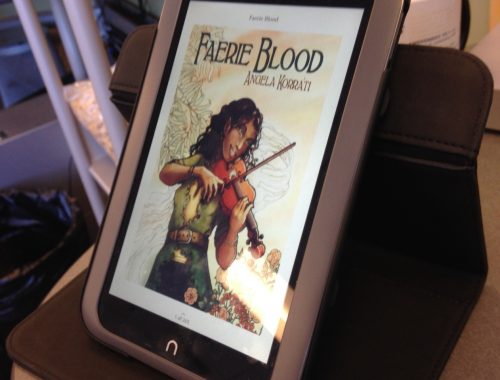Here’s part 3 of my little series of posts about ebooks and ereaders! As I’ve mentioned on previous posts, this series of posts about how to read ebooks and what ereader you might want to get focuses on what reading devices I’ve had personal experience with: the nook and the iPhone.
The nook:
E-ink is pretty damned good overall for emulating the look of an actual printed page.
The big complaint I had initially about an e-ink device is the weird way that it refreshes the screen when you turn a page. I found this extremely distracting at first–but on the other hand, I quickly got over it, particularly after a couple of firmware updates for the nook made that screen refresh faster. I don’t notice it at all now.
A somewhat bigger complaint might be the lack of relative contrast though, depending on what reading conditions you want to read under. I find my nook to be sub-optimal for reading in less than direct sunlight, such as when I’m commuting to work on the bus during the winter, and the bus lights are likely to be turned down in between stops.
Of course, with the original nook, most of the device is an e-ink screen with a touchscreen section at the bottom. This is a bit confusing and I still occasionally catch myself trying to touch the e-ink section of the screen directly to tap pages. Fortunately this actually works, but only sort of.
If you’re interested in a nook (the original model thereof, anyway), I’d recommend going into a Barnes and Noble to handle one first to see if you actually like the interface and the e-ink/touchscreen combo. Ditto for if you’re interested in the new Nookcolor, which is all touchscreen–though I haven’t seen one of these yet myself.
The iPhone:
I definitely go over to reading on the iPhone in low-light conditions, since the phone actually can light the screen for me; in theory I could get a light to put on my nook, but in practice I’d find that a bit too much effort and it’d be just one extra little fiddly bit to have to keep track of.
The phone’s touchscreen is ideal for my reading speed, since I can pretty much just whip right through a book by tapping. Since the screen size is in fact small, I can build up quite the tapping speed as well as I glance at little chunks of page at a time and tap right on through to the next one. On an iPad, I suspect I’d slow down somewhat since it’d be more comparable to the nook in screen size. Now, what reading experience you’ll get on the iPhone or iPad will again depend on what app you’re using. Just about all of the ones I’ve played with, though, will let you configure whether you want to turn pages by tapping or swiping.
Other readers:
It’s worth noting that ![]() seattlesparks
seattlesparks
Overall though I still prefer my nook as my primary reading device, and I’ll get into why in tomorrow’s post: do you want a dedicated reading device?

